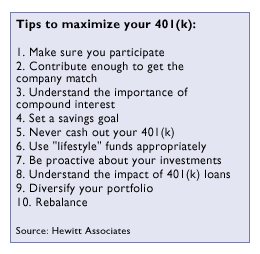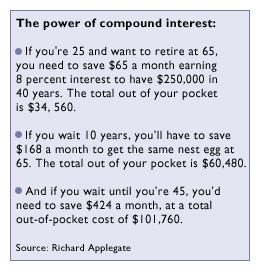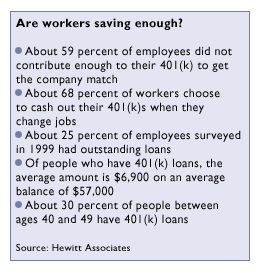|
Get even with the IRS
|
 |
April 16, 2001: 6:56 a.m. ET
Feeling the sting of your tax tab? Your best revenge is to maximize your 401(k)
By Staff Writer Martine Costello
|
NEW YORK (CNNfn) - Oh, how tax pain stings. You sold some stocks and had a huge capital gains tab. Or you underestimated your federal withholding. Either way, you feel singed, tired, and you're not going to take it any more.
Luckily there's a way for you to get revenge against the IRS that's legal and good for you: Your 401(k).
 A company-sponsored retirement plan is one of the best weapons you have to keep your hard-earned money out of the hands of the IRS. You can contribute up to 15 percent of your pre-tax salary and, thanks to the power of compounding, it will grow over the years into a nice sum when you need it. A company-sponsored retirement plan is one of the best weapons you have to keep your hard-earned money out of the hands of the IRS. You can contribute up to 15 percent of your pre-tax salary and, thanks to the power of compounding, it will grow over the years into a nice sum when you need it.
"It's the best middle-class tax break out there," said Pat Jennerjohn, a certified financial planner from Oakland, Calif.
But there are still far too many people who are missing out on 401(k) bounty, according to retirement experts. A new analysis by Hewitt Associate, a 401(k) consultant based in Lincolnshire, Ill, found at least 10 ways where people could take better advantage of their plan and cure the big tax ouch.
Participate – and get the match
While most companies offer 401(k)s, the participation rate at 401(k)s remains around 77 percent, according to Hewitt Associates.
In focus: All about IRAs
How to fight IRA agony
Good funds for your IRA
New IRA distribution rules good for heirs
New IRA rules are taking effect
It's a familiar story for Richard Applegate, a retirement plan adviser and certified financial planner from Allison Park, Pa., who does employee seminars on the topic.
"I can't tell you how many times people will tell me they're not signing up," said an exasperated Applegate. "I don't know if they get it, don't get it, don't care, or what."
In most cases, companies will match your contributions 50 cents on the dollar up to 6 percent, for a total of 3 percent of your salary, financial planners say. If you don't contribute enough to get the match, it's as if you're passing up free money.
According to Hewitt, a study of 150,000 employees found that about 59 percent did not contribute enough to get the company match.
"If you put in four percent and your company puts in four percent, boom, you've made 100 percent on your money regardless of how the market is doing," said Tom Grzymala, a certified financial planner from Alexandria, Va. "If you don't contribute enough to get the match, you're leaving money on the table."
Compounding and your goals
Start early, and your money will work harder for you thanks to the power of compound interest, financial planners say.
 "Delaying is really costly," Applegate said. "If you don't have time on your side, you don't have compounding." "Delaying is really costly," Applegate said. "If you don't have time on your side, you don't have compounding."
Let's say you're 25 and want to retire at 65, Applegate said. You save $65 a month earning 8 percent interest and in 40 years you've got $250,000. The total out of your pocket is $34,560.
Wait 10 years and you'll have to save $168 a month to get the same nest egg at 65. The total out of your pocket is $60,480.
But it gets worse. If you wait until you're 45, you'd need to save $424 a month to wind up with $250,000 a 65, at a total out-of-pocket cost of $101,760. And if you wait until you're 55, you'd need to save $1,367 a month, or $164,040 out of your pocket.
Hewitt found in another study of 500,000 employees that about 46 percent of people age 20 to 29 don't contribute at all to a 401(k). Those people could fall far short of their retirement goals, Hewitt said.
It's important for people to set a contribution rate that meets their savings goals, Hewitt said. Don't just pick a round number like 5 or 10 percent.
For every $1,000 you contribute to your 401(k), you save about $400 in taxes, said Scott Kahan, a certified financial planner in New York.
| |
 A POWERFUL TAX-SAVING TOOL A POWERFUL TAX-SAVING TOOL
|
|
| |
|
For every $1,000 you contribute, you save about $400 in taxes.
|
|
|
Your 401(k) contributions may also reduce your adjusted gross income, which could make you eligible for a Roth IRA, Kahan said. With a Roth IRA, the contributions aren't tax-deductible but the money is tax free when you withdraw. The income limit for a Roth is $95,000 for a single person and $150,000 for a couple.
Special report: Tax time!
"With a 401(k), people don't realize how much they can save in taxes," Kahan said. "They're clueless."
Plus, your 401(k) contributions are made with pre-tax money, so it won't take as much of a bite out of your paycheck as you think, Jennerjohn said.
"It's pre-tax dollars, so if you put away $100 it's only a $60 difference in your paycheck," Jennerjohn said.
Loans and lump payments
By far, the worst thing in the world that you can do to your 401(k) is cash it out.
"Wrong, wrong, wrong, stupid," Applegate said. "Taking the money out is absolutely the worst thing to do. You see people after years have all of their gains wiped out."
The IRS will make you pay for it, too. You'll pay a flat penalty of 10 percent of the amount withdrawn, as well as income taxes. That means you'll lose roughly half of your balance to taxes and penalties.
 "People look at their 401(k)s as a credit union," Applegate said. The only exception would be a medical emergency, he said. Many plans allow "hardship withdrawals" for certain reasons. "People look at their 401(k)s as a credit union," Applegate said. The only exception would be a medical emergency, he said. Many plans allow "hardship withdrawals" for certain reasons.
Hewitt found that nearly 68 percent of people in a study choose lump payments when they change jobs. About 26 percent roll their balances into IRAs and only 6 percent move their money into their new employer's plan.
Applegate said companies offer loan provisions to make 401(k)s seem more attractive and to allay fears that once they contribute they lose control of the money.
But the danger of a loan is if you change jobs or the company goes out of business, you'll have to pay the balance, Jennerjohn said.
And, if you borrow from your 401(k) for a down payment on a house, when you're evaluated for a mortgage, that loan will be listed as a liability, she said.
"I would never use (a loan) for a long-term commitment," Jennerjohn said.
According to Hewitt, nearly 25 percent of 400,000 plan participants had outstanding loans in 1999. The average loan amount was $6,900 on an average balance of $57,000. And nearly 30 percent of people age 40 to 49 – who have retirement around the corner -- had loans, Hewitt said.
Diversification and smart investing choices
Of course, recent market losses have shaken a lot of 401(k) investors, which underscores the importance of a diversified portfolio, Jennerjohn said. That means spreading your investments between different types of stocks and bonds, depending on your age and risk tolerance.
| |

|
|
| |
|
|
| |
Wrong, wrong, wrong, stupid.
|
|
| |
|
|
| |

|
|
| |
|
|
| |
Richard Applegate,
on cashing out your 401(k) |
|
Don't dump holdings just because they are down, Jennerjohn said. All that does is lock in your paper losses.
"This market is so punishing ... everything will go down," Jennerjohn said. "But over time, things will pop back up."
The idea is to trim your winners and buy more of the losers and don't rebalance until your allocations have changed by more than 5 percent, she said.
If the choices are limited in your plan, choose as best you can and balance out your portfolio with other options in an IRA, Grzymala said.
Build your retirement strategy: The Road to Riches.
Many people go into "autopilot" with their 401(k)s and leave their money in the "default" investing choice, which can often be much too conservative, Hewitt said.
Hewitt also found many 401(k) investors improperly use "lifestyle," or "lifecycle" funds, which match investing goals to people in different age groups and risk tolerance.
You can't escape Uncle Sam forever
While you can build a larger nest egg and keep your dollars away from the IRS, you can't hide your money forever. Eventually you'll have to pay that tax tab, when you make withdrawals. But it's likely you'll be at a lower income tax bracket, so the bite might will probably not be as big.
"Eventually, you're going to pay those taxes," Grzymala said. 
|
|
|
|
|
 |

|

